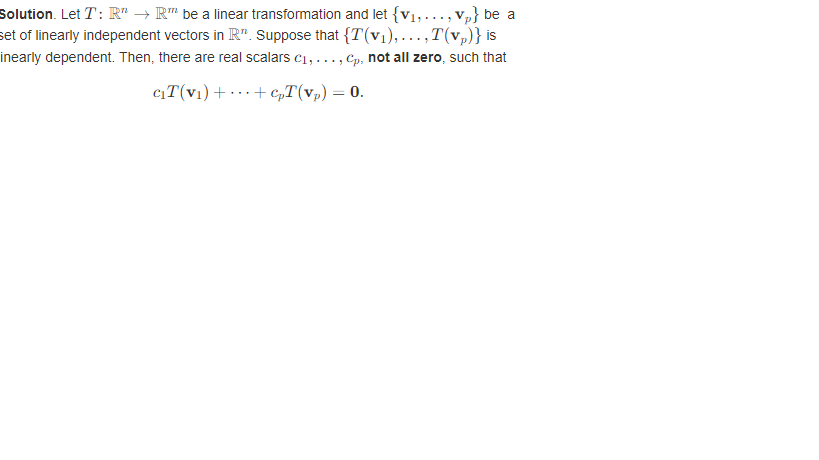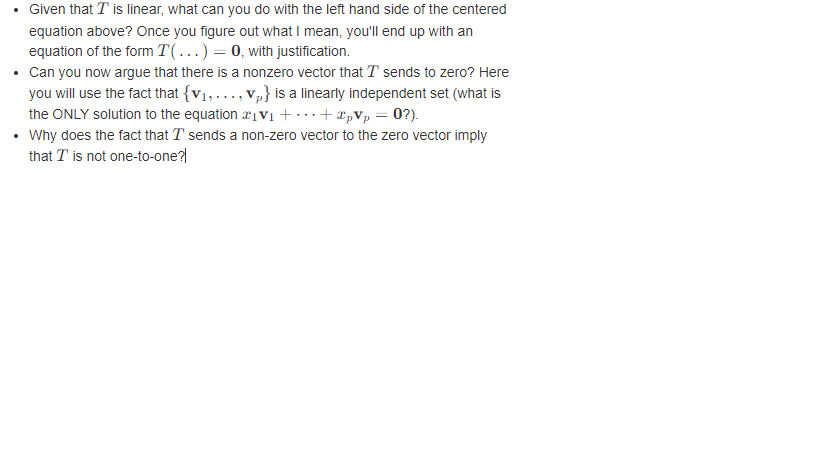olution. Let T: R" →→R" be a linear transformation and let {v₁,..., vp} be a et of linearly independent vectors in R". Suppose that {T(v₁),...,T(v₂)} is hearly dependent. Then, there are real scalars c₁,..., Cp, not all zero, such that C₁T(v₁) ++ cpT(vp) = 0.
olution. Let T: R" →→R" be a linear transformation and let {v₁,..., vp} be a et of linearly independent vectors in R". Suppose that {T(v₁),...,T(v₂)} is hearly dependent. Then, there are real scalars c₁,..., Cp, not all zero, such that C₁T(v₁) ++ cpT(vp) = 0.
Linear Algebra: A Modern Introduction
4th Edition
ISBN:9781285463247
Author:David Poole
Publisher:David Poole
Chapter6: Vector Spaces
Section6.4: Linear Transformations
Problem 24EQ
Related questions
Question

Transcribed Image Text:Solution. Let T: R" → R™ be a linear transformation and let {V₁,..., vp} be a
set of linearly independent vectors in R". Suppose that {T(v₁),...,T(v₂)} is
inearly dependent. Then, there are real scalars c₁,..., Cp, not all zero, such that
C₁T (V₁) +
+ cpT(vp) = 0.

Transcribed Image Text:• Given that I is linear, what can you do with the left hand side of the centered
equation above? Once you figure out what I mean, you'll end up with an
equation of the form T(...) = 0, with justification.
Can you now argue that there is a nonzero vector that I sends to zero? Here
you will use the fact that {V₁,..., Vp} is a linearly independent set (what is
the ONLY solution to the equation ₁V₁ ++ pvp = 0?).
• Why does the fact that I sends a non-zero vector to the zero vector imply
that I' is not one-to-one?|
Expert Solution
Step 1: Introduction
Given that is a linear transformation.
Suppose that is the set of linearly independent vectors such that
is linearly dependent.
We need to prove that is not one-one.
We know that for zero vector
and
.
We know that, if is a linear transformation, then
, where
are vectors and
is scalar.
Trending now
This is a popular solution!
Step by step
Solved in 3 steps with 23 images

Recommended textbooks for you

Linear Algebra: A Modern Introduction
Algebra
ISBN:
9781285463247
Author:
David Poole
Publisher:
Cengage Learning

Elementary Linear Algebra (MindTap Course List)
Algebra
ISBN:
9781305658004
Author:
Ron Larson
Publisher:
Cengage Learning

Linear Algebra: A Modern Introduction
Algebra
ISBN:
9781285463247
Author:
David Poole
Publisher:
Cengage Learning

Elementary Linear Algebra (MindTap Course List)
Algebra
ISBN:
9781305658004
Author:
Ron Larson
Publisher:
Cengage Learning